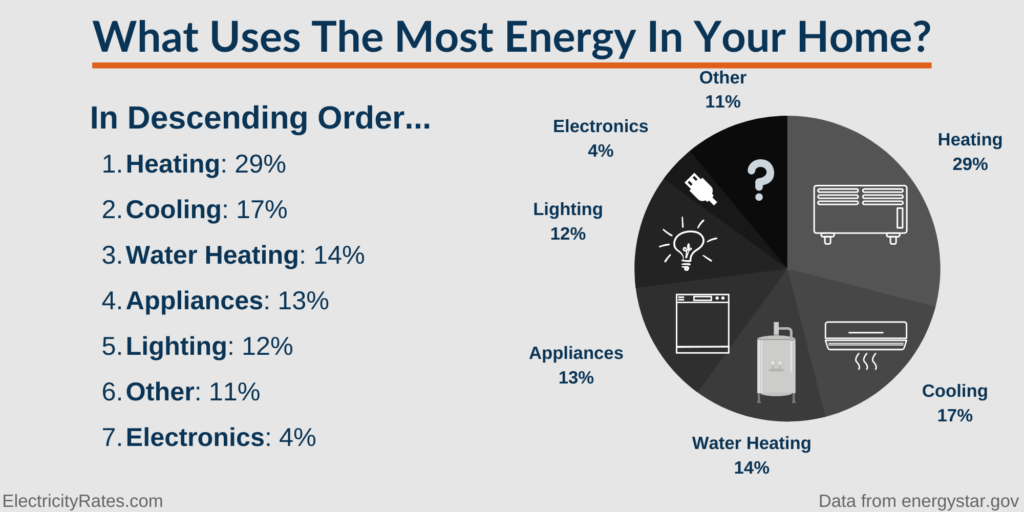The browser you are using is not supported. Please consider using a modern browser.

Why Your Electricity Usage Matters
Consumers who’ve had the opportunity to study their electricity bills may have noticed that the majority of their total costs are comprised of two primary charges – energy charges and utility charges. Energy charges are what you pay for how much electricity you use.
Understanding how your electricity usage impacts the energy charges on your bill can help you determine the best ways to limit usage and save money. In addition to understanding what uses the most power, you can also use this information to get a lower rate, so that months with high usage aren’t so hard on your wallet.
How Much Electricity Does the Average Home Use?
According to the U.S. Energy Information Administration (EIA), the average annual electricity consumption for a U.S. residential utility customer was 10,972 kilowatt-hours (kWh), an average of about 914 kWh per month.
Electricity consumption in the U.S. was about 3.95 trillion kilowatt-hours (kWh) according to the latest data*. Tennessee has the highest annual electricity consumption at 15,394 kWh per residential customer, and Hawaii had the lowest at 6,213 kWh per residential customer.
Find more information on average energy usage and costs for states with Energy Choice below.
- Connecticut
- Georgia
- Illinois
- Maryland
- Massachusetts
- Michigan
- New Hampshire
- New Jersey
- New York
- Ohio
- Pennsylvania
- Rhode Island
- Texas
Finding Your Electricity Usage
Electricity usage reflects the actual amount of electricity you’ve consumed during the billing cycle. Customers can usually determine their energy usage by looking at their past bills or by estimating their usage based on several factors. Home energy management is all about tracking how much electricity your house or apartment uses, then finding ways to save.
Finding Electricity Usage on Your Bill
The easiest way to find your electricity usage is by looking at your prior electricity bills. Usage is reflected in kilowatt-hours (kWh). This will vary depending on the month and how much energy you’ve used so the best way to get your average usage will be to compare several months of bills.
Estimating Your Electricity Usage
If you’ve recently moved and don’t have any electricity bills to look at, you can ask neighbors, the landlord, or previous residents to get an idea of what your usage might be in the new home.
If you’re moving into a new home or apartment but will be using the same electricity provider, the provider may be willing to provide estimates for the new dwelling as a courtesy. Here is an approximate range of electricity usage that you may be looking at:
An average one-bedroom apartment (appx. 750 square feet) uses about 750 kWh/month, with usage increasing to about 880 kWh/month for an apartment of 1,000 square feet. The average single-family home uses about 914 kWh/month, with the average for larger homes coming in at around 1200 kWh/month (Source: EIA).
Helpful Resources:
What uses the Most Electricity in my Home?
Although every appliance in a home consumes energy, utilizing each one will have a different impact on your monthly electricity bill. Understanding which appliances use the most energy, as well as when they’re pulling power from the grid, can help you save on monthly utility bills.

Heating and cooling account for a majority of electricity usage in the home followed my major appliances.
Helpful Resources:
-
Calculating Your Energy Consumption
How Can I Lower my Electricity Usage?
For many homeowners, the monthly utility bill is their second-largest expense after the mortgage. Reducing energy usage isn’t just about being a good steward of the environmentit’s also a great way to keep your budget in check.
There are all sorts of ways to lower electricity usage, and countless tips and resources are available to help energy customers lower their bills.Generally, there are two schools of thought on cutting your electric use in the Home:
Energy Conservation
Conservation means avoiding using unnecessary energy, such as unplugging electronics when not in use while also limiting current energy use, such as not turning on a heater at night when a couple of extra blankets will do.
Energy Efficiency
Efficiency addresses making improvements to your Home so that less energy will be required to keep it comfortable. In this case for example, rather than turning the heater off, you might invest in a “smart” thermostat that automatically adjusts the temperature, or upgrade to an HVAC unit that would need less energy to maintain the same level of comfort in your home.
A few tried-and-true examples for lowering electricity usage include:
- Performing an energy audit to determine how efficient your Home’s energy usage is.
- Cutting out phantom energy drains (from appliances that use energy even when they’re turned off), which can account for up to 75% of your energy use.
- Using dimmer switches to reduce how much energy is drawn from lights in the Home (which saves energy and money).
- Keeping your refrigerator and freezer full. All of the edibles in a refrigerator and freezer act as insulation, reducing the need for cooling.
- Keeping refrigerator coils clean. Very few homeowners know about this one. A refrigerator can use between 201 kWh to 500 kWh per year, depending on the type, and dirty coils reduce a refrigerator’s efficiency, resulting in higher usage and cost to the customer.
Helpful Resources:
How Can I Lower my Electricity Rate?
Residents in states with Energy Choice programs enjoy the ability to switch their energy provider and secure a lower electricity supply rate for their homes. This is especially useful for higher use months when your electricity usage spikes. To get started, enter your ZIP Code at the top of the page!